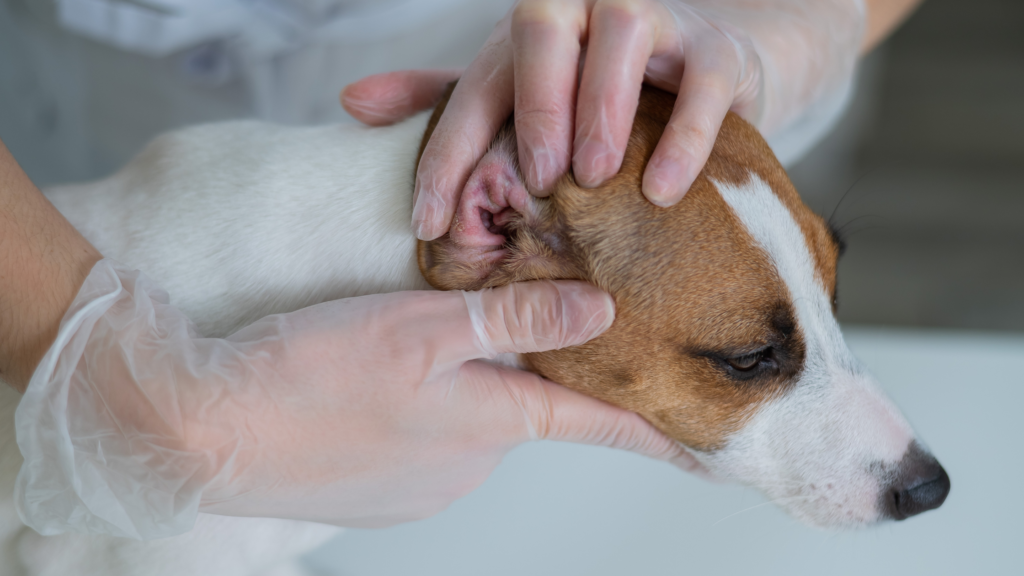Polysporin for Dogs – Ah, Polysporin—the familiar antibiotic skin ointment found in many stores across the United States, ready to come to the rescue for minor wounds and abrasions in humans.
But can this popular ointment be used to treat your dog’s wounds?
Ah, the temptation to grab that over-the-counter antibiotic and take matters into your own hands! However, veterinary health experts generally advise against it.
But fear not! There are situations where Polysporin can safely treat your furry friend’s wounds. Let’s dive in and uncover the truth behind Polysporin’s role in your dog’s wound care.
What is Polysporin, Anyway?
Polysporin is the catchy brand name for an over-the-counter antibiotic skin ointment and antibiotic eye and ear drops manufactured by the well-known Johnson & Johnson.
This wonder ointment contains a combination of two antibiotics: bacitracin zinc and polymyxin B sulphate.
It’s widely available and easily accessible in stores throughout the United States.
However, it’s important to note that Polysporin eye and ear drops are not sold in the United States except on eBay.
Instead, they can be found over the counter in Canada.
Safety First: Is Polysporin Safe for Dogs? Are Polysporin ear drops safe for dogs?

Is Polysporin Safe for Dogs?
Here’s the deal: Polysporin is a skin antibiotic ointment used to treat human skin infections, specifically minor cuts.
So, can it be used for your dog’s skin? Yes, but with a few precautions.
Polysporin skin ointment can be used safely for minor cuts or injuries on your dog’s skin, but this should only be done under veterinary supervision.
Are Polysporin ear drops safe for dogs?
It’s important to remember that Polysporin ear and eye products are intended for human use and are ineffective in treating canine eye or ear infections.
Keep those Polysporin ear drops away from your dog’s precious peepers and floppy ears!
Polysporin versus Neosporin: The Battle of the Ointments
In wound care for dogs, Polysporin faces stiff competition from its triple antibiotic ointment counterpart, Neosporin.
Professionals in the United States tend to lean more towards Neosporin than Polysporin, mainly because Neosporin contains an additional ingredient that Polysporin lacks: neomycin sulphate.
Neosporin comes in two versions: an over-the-counter skin ointment for minor cuts in humans and a prescription Neosporin Ophthalmic for humans, also available in veterinary ophthalmic versions.
Remember, over-the-counter Neosporin should never be used in your dog’s eyes or ears—stick to the prescription version for those sensitive areas.
Also Read: Can Dogs Eat Nopales? Discover the Benefits and Tasty Recipes!
Navigating the Proper Use of Polysporin on Dogs
Let’s discuss where you can safely use Polysporin on your four-legged pal.
The key takeaway is that Polysporin skin ointment is specifically meant for human skin abrasions and should never be used in your dog’s eyes or for treating ear infections.
Instead, it can be cautiously used on minor scrapes on your furry friend.
However, it’s crucial to consult with your veterinarian before applying Polysporin to your dog’s skin.
Certain wounds, such as hot spots (pyoderma), deep wounds, or rashes from serious allergic reactions, require professional care and may not be suitable for Polysporin treatment.
Exploring Alternatives to Polysporin for Your Dog’s Wounds
When treating your dog’s minor wounds, you may wonder if there are natural alternatives to Polysporin.
Well, good news! Some alternative veterinarians prefer natural treatment options to clean and speed up the healing process of minor dog wounds. These options include:
- Normal Saline Solution: This simple yet effective solution can gently cleanse the wound and promote healing.
- Alcohol-Free Witch Hazel: In small quantities (only once or twice a day), witch hazel can clean the wound and provide some antiseptic properties. However, it’s important to note that witch hazel should not be used on dry skin as it can worsen the condition.
- Turmeric: Known for its anti-inflammatory and antimicrobial properties, turmeric can be applied topically to aid in wound healing. However, it’s advisable to consult with your veterinarian before using turmeric on your dog.
- Herbal Tree Rinses: Chamomile or St. John’s wort rinses can be used as natural wound cleansers and may help soothe and promote healing. Always dilute these herbal extracts appropriately and follow your veterinarian’s advice.
- Medical-Grade Honey Ointment: Honey has long been recognized for its antibacterial properties and ability to promote wound healing. The medical-grade honey ointment can be applied to minor wounds, but consult your veterinarian before using it.
Remember, discussing these natural remedies with your veterinarian before using them on your dog is crucial.
They will provide guidance based on your dog’s specific needs and the nature of the wound.
Precautions When Using Polysporin on Dogs

While Polysporin is generally safe for minor scrapes and abrasions on dogs, there are a few precautions to remember.
Firstly, neither Polysporin nor Neosporin skin ointments should ever be applied to your dog’s eyes or ears.
These products are not formulated for such use and may cause serious side effects if ingested or applied incorrectly.
If your dog shows any signs of allergic reactions or swelling after using Polysporin, contact your veterinarian immediately.
It’s important to note that Polysporin Ear is ineffective in treating ear mites, yeast infections, or other common causes of ear infections in dogs.
For any discomfort or infection in your dog’s ears, it’s best to have it assessed and treated by a veterinarian.
Also Read: The Power of Aggressive Dog Board and Train Programs
Polysporin for Dogs – The Takeaway: Contact Your Veterinarian
In conclusion, Polysporin can have a role in treating minor cuts and wounds on dogs’ skin, but it should only be used under veterinary supervision.
Never put Polysporin or Neosporin in your dog’s eyes or ears, as these products are not intended for such use.
Regarding your dog’s health, it’s always best to consult your veterinarian for proper diagnosis, guidance, and treatment.
They will recommend the most appropriate action based on your dog’s condition, ensuring the best possible care and outcome.
So, next time your four-legged companion has a wound, reach out to your DVM and let them guide you on the best course of action.
Together, you’ll ensure your dog receives the care they deserve and help them heal quickly!







